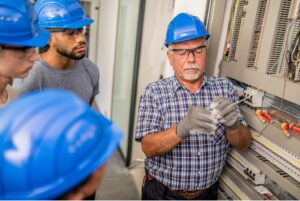In response to growing labor shortages and the urgent need for skilled workers in the trades, spatial computing and immersive technologies have emerged as powerful tools to modernize job training. At the forefront of this innovation is BILT Incorporated, whose partnership with Warshauer Trade in New Jersey demonstrated how immersive instruction—delivered through Apple Vision Pro—can significantly accelerate training and improve learning outcomes.
The Case for Immersive Technical Training
The 12-week study conducted by BILT and Deloitte involved 17 electrical students enrolled in a contractor certification program. The objective was to evaluate how BILT 3D Immersive Instructions, accessed via Apple Vision Pro, could improve comprehension, confidence, and speed of skill acquisition. Three of the course’s 10 projects were enhanced with spatial learning modules that allowed students to interact with 3D digital twins in real space, combining audio, animated guidance, and real-world context.
What makes BILT’s implementation unique is its seamless integration into the classroom environment. Students were not removed from hands-on practice—they were empowered by it. By overlaying digital guidance into the physical environment, trainees could safely and confidently explore technical tasks before ever handling tools or materials.
Key Findings from the Immersive Technical Training Study
The results of the Warshauer Trade study were striking and measurable across several performance indicators:
- Time-to-Proficiency: Students performed tasks such as mounting electrical boxes 73% faster compared to previous cohorts, cutting average time from 40 minutes to just 11. Even the slowest students improved by nearly 20%, showing across-the-board acceleration.
- Task Completion Speed: For select spatial-enhanced modules, learners completed tasks up to 89% faster.
- Course Completion Efficiency: On average, students completed the curriculum nearly 25% faster than their peers using traditional instruction alone, with the majority finishing 2.5 to 3 weeks ahead of schedule.
- Error Elimination: Immersive technical training instruction effectively eliminated the most common technical errors. Reverse polarity mistakes (historically seen in 18% of students) and sheathing errors (previously at 20%) dropped to zero. Errors in complex traveler wire connections declined by 90%.
- Knowledge Retention: Knowledge retention tripled, reaching up to 90% for key concepts—highlighting how immersive technical training enhances long-term learning.
- Consistency: Variance in task completion times dropped dramatically, enabling more predictable and uniform outcomes across the cohort.
- Confidence Boost: 93% of students reported feeling confident and ready to apply their new skills in the field, echoing instructors’ observations of improved autonomy and performance.
Why Immersive Technical Training Works
BILT’s Immersive Instructions on Apple Vision Pro combine the best of visual, auditory, and kinesthetic learning. This approach is especially effective for visual learners and those who struggle with text-heavy manuals. Instructors noted that immersive technology reduced the number of repeat questions and made troubleshooting simpler for students, who could revisit instructions independently at any time.
Hands-free operation enabled students to view the instructions while physically working, enhancing real-time application. The pass-through capability of Apple Vision Pro allowed students to stay grounded in the physical environment while interacting with high-fidelity 3D content. Unlike traditional VR headsets, Apple Vision Pro kept learners situationally aware, which proved essential in hands-on learning spaces.
Instructor Feedback
Both instructors involved in the study initially expressed skepticism about introducing advanced tech into the workshop. However, they quickly became advocates for the solution. One instructor remarked that the speed of learning was so fast, it was hard to keep up with students. Another emphasized that for the first time, students were completing early-stage projects with precision and clarity, reducing the need for corrective feedback.
The graphics, fidelity, and intuitive interface of the Apple Vision Pro left a particularly strong impression. As one instructor noted, “The students were over the moon with the graphics… They’re lifelike and right in front of you.”
Enterprise Implications of Immersive Technical Training
While the study was based in a trade education setting, the implications for enterprise training are profound. The consistent, rapid, and safe upskilling enabled by BILT’s platform positions it as an ideal solution for industries with high training costs, safety concerns, and technical complexity—such as construction, manufacturing, energy, and aerospace.
By shortening learning curves and boosting confidence, immersive instruction empowers workers to become productive sooner, reduces costly errors, and fosters workforce engagement. Organizations integrating BILT for Apple Vision Pro into their training programs can expect significant returns in efficiency, safety, and scalability.
Conclusion
The BILT case study at Warshauer Trade is a powerful validation of how spatial computing and immersive instructions can transform workforce training. With 25% faster course completion, zero error rates in critical tasks, and 200% gains in retention, BILT for Apple Vision Pro is not just a better way to train—it’s a smarter, safer, and more scalable solution for building the next generation of skilled professionals.



